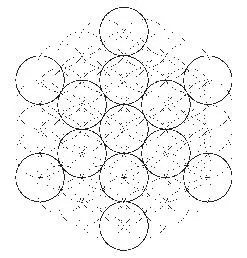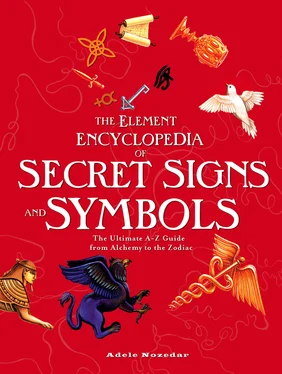Some important symbolic sequences can be derived from manycircled versions of the design, for example Metatron’s Cube can be derived from the Flower of Life, and the five Platonic solids can then be “extracted” from Metatron’s Cube. As if these fundamental principles of sacred geometry were not enough, the Kabbalistic Tree of Life can be discerned within the Flower of Life, as can the Seed of Life.
For many, the Flower of Life is an object of mystery which may well unlock the secrets of the Universe, since they believe that it contains a record of information about all living things. The Flower of Life is used as a focus both for study and meditation.
See Y of Pythagoras.

The Flower of Life pattern, if constructed of at least five circles down and across, holds another symbol within it. This is the Fruit of Life, formed from a six-rayed star of five circles in all directions. There are 13 circles in total. This star shape then gives the foundation for the construction of Metatron’s Cube, from which, in turn, the five Platonic solids can be made.

In China, the Fu is an ancient symbol of good luck, and is still popularly used in talismans and charms. The word “Fu” sounds like the word for bat; so, by association, bats are auspicious, too, especially if they are five in number. The actual ideogram of Fu shows a God blessing a farm, which is an analogy for the Earth; the farm is split into four parts, the four parts resembling the four directions and the four elements.
See Y of Pythagoras.
The gammadion is a form of swastika, but with shorter arms, and is so called because it is constructed from four Greek “gamma” letters. This sign was widespread, appearing across Europe and through to India. Like the swastika, it is a solar symbol, and the four arms of the symbol represent all the universal objects and concepts that come in groups of four: the directions, the seasons, the elements, the solstices, and the equinoxes.
See Gungnir.
Every week of the year, on most continents around this planet, millions of people participate in a profoundly magical ritual whereby two very basic everyday foodstuffs, which are available in supermarkets or on stalls pretty much anywhere you care to mention around the world, have a spell cast over them by means of a sacred incantation. The person officiating over this ceremony makes symbolic gestures with his or her hands and arms. This spellbinding usually takes place in a language very few fully comprehend, a language full of secrets, and as a result these mundane objects are transformed into something as mystical, sacred, and awe-inspiring as anything you could ever imagine.
In addition, this ritual generally takes place in a building whose architecture and design has been informed by knowledge of the directions, shapes, and patterns that link the Heavens with the Earth in an arrangement of the sacred symbols which some say were dictated to man by the very angels themselves.
When the Holy Communion of the Roman Catholic Church takes place, the simple ingredients of bread and wine are transformed, many believe, into the actual body and blood of the Christ. This is not just a symbolic representation, some say, but a very real and profound belief that underpins the foundations of the religion. By eating this holy, sacred food, imbued with magical intent, the recipient voluntarily absorbs the spirit of the Messiah.
The ritual and perceived reality of this act are inseparable, but bread and wine are not the only sacred foods we absorb as part of our everyday lives. We need food to live, so it comes as no surprise that we have accorded many ingredients with magical powers. Indeed, some of the things we eat every day carry both constituent elements and meanings which go far beyond mere nutrition. Many other foods—nuts, apples, and other fruits and vegetables—are covered in other sections of this book, and this is by no means an exhaustive inventory, but a look at some of the foods, real and mythical, which have become symbols in themselves.
For the Greeks, ambrosia was the food of the Gods. Given that it conferred immortality, the deities on Mount Olympus guarded it jealously. As well as ensuring eternal life, ambrosia could be used as an ointment that could heal any wound. However, for a mortal, eating ambrosia was a big mistake. Take the story of Tantalus, for example. He was invited to eat with the Gods, and so, presuming that he was accepted as one of them, he ate ambrosia. In the tradition of all good dinner party guests, he decided to return the favor and invited the Gods round to his place. Deciding somewhat sycophantically that they should feast upon all the good things that they had given him, he served up the flesh of his own children, and was banished to Hades.
Long before the Western discovery of the Americas, the natives of Brazil, Mexico, the West Indies, and South America used the seeds of the chocolatl tree to make a stimulating drink. These bean-like seeds were cacahuatl, or cocoa. Primarily symbolic of love, chocolate is a sensual food with aphrodisiac properties that are due, in part, to association. However, its melting point is the same temperature as blood, a very satisfying sensation.
The botanical name of the plant gives a clue as to its sacred status. Theobroma cacao means “food of the Gods,” from the Greek “Theo,” meaning God and “Broma,” meaning food.
The beans were so highly valued that the Mayans used them as currency. Possibly the world’s first chocoholic, their ruler Montezuma was completely addicted to the beans. He drank them infused in cold water with no seasoning. He served this sacred drink in goblets of beaten gold, and at the coronation of Montezuma II in 1502 a concoction of chocolate and psilocybin mushrooms was served to the guests. This must have been a heady mixture.
Cortés cultivated the plant primarily because of its reputation as an aphrodisiac; this secret was divulged by one of the nineteen young women given to him by Montezuma as a tribute. Perhaps the 2000 chocolatl trees that he consequently planted were testimony to the efficacy of the beans in keeping the ladies satisfied.
By 1550, chocolate factories were operating in Lisbon, Genoa, Marseilles, and other European cities. The recipes became more and more refined. Catherine de Medici slowed down the progress of chocolate for a while because it was so good that she wanted it all to herself. However, although the Church tried to ban many of the foodstuffs that had been discovered in the New World, especially those that were considered as stimulants, their advice was largely ignored and it is possible that this disapproval increased the popularity of this illicit substance. Neither Catherine nor all the forces of the Church could stop the world becoming chocolate coated.
Today, the form of chocolate has changed so much that Montezuma would probably find it unrecognizable, both in taste and form. However, it is still unrivalled as a token and symbol of love.
Legislation decrees that all packaged food carry a “best before” date, but this seems to be particularly unnecessary in the case of honey, since jars of the stuff found in the tombs of Egyptian kings of several thousand years ago has proved to be perfectly edible even now. It could well be because honey is so long lasting, and because it is used as a preservative, that it is a symbol of immortality and is used in funerary rites. The bees that make the honey have their place in the realms of magical creatures accorded with supernatural powers, but more of that in the Fauna section. The Promised Land is said to “flow with milk and honey” as being the very best that the Gods can offer.
Читать дальше














